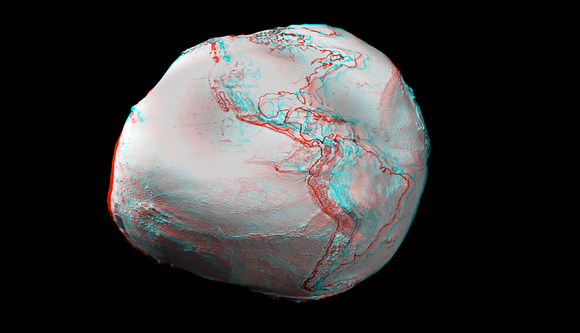[/caption]
The constant of gravity, or gravity constant, has two meanings: the constant in Newton’s universal law of gravitation (so is commonly called the gravitational constant, it also occurs in Einstein’s general theory of relativity); and the acceleration due to gravity at the Earth’s surface. The symbol for the first is G (big G), and the second g (little g).
Newton’s universal law of gravitation in words is something like “the gravitational force between two objects is proportional to the mass of each and inversely proportional to the square of the distance between them“. Or something like F (the gravitational force between two objects) is m1 (the mass of one of the objects) times m2 (the mass of one of the other object) divided by r2 (the square of the distance between them). The “is proportional to” means all you need to make an equation is a constant … which is G.
In other words: F = Gm1m2/r2
The equation for little g is simpler; from Newton we have F = ma (a force F acting on a mass m produces an acceleration a), so the force F on a mass m at the surface of the Earth, due to the gravitational attraction between the m and the Earth is F = mg.
Little g has been known from at least the time of Galileo, and is approximately 9.8 m/s2 – meters per second squared – it varies somewhat, depending on how high you are (altitude) and where on Earth you are (principally latitude).
Obviously, big G and little g are closely related; the force on a mass m at the surface of the Earth is both mg and GmM/r2, where M is the mass of the Earth and r is its radius (in Newton’s law of universal gravitation, the distance is measured between the centers of mass of each object) … so g is just GM/r2.
The radius of the Earth has been known for a very long time – the ancient Greeks had worked it out (albeit not very accurately!) – but the mass of the Earth was essentially unknown until Newton described gravity … and even afterwards too, because neither G nor M could be estimated independently! And that didn’t change until well after Newton’s death (in 1727), when Cavendish ‘weighed the Earth’ using a torsion balance and two pairs of lead spheres, in 1798.
Big G is extremely hard to measure accurately (to 1 part in a thousand, say); today’s best estimate is 6.674 28 (+/- 0.000 67) x 10-11 m3 kg-1 s -2.
The Constant Pull of Gravity: How Does It Work? is a good NASA webpage for students, on gravity; and the ESA’s GOCE mission webpage describes how satellites are being used to measure variations in little g (GOCE stands for Gravity field and steady-state Ocean Circulation Explorer).
The Pioneer Anomaly: A Deviation from Einstein’s Gravity? is a Universe Today story related to big G, as is Is the Kuiper Belt Slowing the Pioneer Spacecraft?; GOCE Satellite Begins Mapping Earth’s Gravity in Lower Orbit Than Expected is one about little g.
No surprise that the Astronomy Cast episode Gravity covers both big G and little g!

